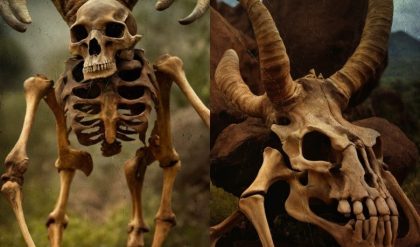In a bizarre and controversial event, a 2,800-year-old mummy described as having the head of a mammoth and the body of a human was recently auctioned in the United Kingdom, sparking an uproar from both historians and the general public. This unique artifact, allegedly from ancient Egypt, challenges everything we know about the region’s history and burial customs—and its sale to a private collector has ignited a fierce debate over the ethics of selling such historically significant items.
The Mysterious Mummy: A Creature of Legend or an Archaeological Enigma?
The mummy, discovered by an anonymous private collector in Egypt in the 1920s, was reportedly kept hidden from the public for nearly a century before surfacing on the auction block. Its most distinguishing feature—the head of what appears to be a prehistoric mammoth attached to a human body—has left many experts baffled and questioning its authenticity.

- Physical Description: The body, roughly six feet in length, is wrapped in linen typical of Egyptian mummification practices. However, instead of a human head, the mummy sports the massive skull and tusks of a mammoth, an extinct species that roamed the earth thousands of years ago. The sight of a human body coupled with such an ancient creature’s head is both grotesque and mesmerizing, igniting curiosity about how it was created.
- Historical Incongruence: While mammoths and humans coexisted briefly in prehistory, the idea of a mammoth-headed human mummy from Egypt—dated to roughly 800 B.C.—has no precedent in archaeological records. Some theorists speculate that it could represent a symbolic or ritualistic amalgamation of two sacred beings, while others see it as a possible hoax.
Public Outcry: A Clash Between Science, Ethics, and Commerce
The auction, hosted by a prestigious UK-based auction house, attracted worldwide attention, with bids skyrocketing into the millions before the hammer fell. However, the sale has sparked widespread condemnation from scholars, activists, and cultural heritage organizations who argue that such an extraordinary and potentially invaluable artifact should not be sold to the highest bidder.
- Ethical Concerns: Critics argue that historical artifacts, especially those as rare and controversial as this mummy, should remain in museums or be subject to scientific investigation, rather than ending up in private hands. Egyptologists and archaeologists alike have decried the auction, calling it a “disgrace” and a violation of international laws aimed at preserving ancient heritage.
- Calls for Repatriation: Egyptian authorities have also voiced their objections, calling for the immediate return of the mummy to Egypt. They assert that the artifact, if authentic, belongs to Egypt’s cultural history and should be studied within the country where it was discovered. Egypt has a longstanding legal framework that bans the export of antiquities, making the sale even more controversial.
Scientific Skepticism: Is the Mummy Real?
As the controversy continues to grow, experts are divided on whether the mummy is a genuine artifact or an elaborate hoax. The combination of a human body with a mammoth head has never been documented before, and many archaeologists are urging caution before jumping to conclusions.
- Possible Explanations: Some suggest that the mummy could have been the product of a highly unusual burial ritual, where ancient Egyptians combined the remains of a human with those of a revered animal to create a symbolic or spiritual figure. Mammoths, while not native to Egypt, could have been brought there through trade or migration routes during earlier periods, though this theory remains speculative.
- DNA Testing and Analysis: Scientists are calling for detailed DNA analysis and carbon dating to determine the authenticity of the mummy. If it proves genuine, it could radically alter our understanding of ancient Egyptian funerary practices. However, no such testing has been conducted publicly as of yet, leaving room for doubts about the mummy’s origins.
Cultural Impact and Speculation: Why Does This Matter?
The discovery of the mammoth-headed mummy has reignited debates about the ethics of archaeological discoveries, ownership of ancient artifacts, and the role of private collectors in preserving history. It also taps into broader cultural fascinations with hybrid creatures and mythical beings.
- Symbolism and Myth: The idea of hybrid creatures—part human, part animal—has long been a staple of mythology in many ancient cultures, including Egypt, which featured gods such as Anubis, who had the head of a jackal and the body of a man. Some suggest that this mummy could be a reflection of an ancient belief system where humans were physically merged with animals to attain divine status.
- Fueling Conspiracy Theories: As with many mysterious finds, the auction has spurred a host of conspiracy theories, with some speculating that the mummy could be evidence of ancient genetic experimentation or even alien influence. These ideas, while far-fetched, have gained traction on social media, further fueling public interest in the case.
The Future: What’s Next for the Mummy?
While the sale of the mammoth-headed mummy has gone through, the debate surrounding its authenticity, legality, and future is far from over. Scholars and the Egyptian government are pushing for further investigation and a possible return to Egypt, while the new private owner remains anonymous, fueling speculation about their motives and plans for the artifact.
- Scientific Investigation: Many in the academic community hope to conduct a thorough scientific examination of the mummy, using modern techniques such as DNA analysis, radiocarbon dating, and 3D scanning to uncover more about its origins and whether it is indeed a genuine artifact.
- International Legal Battle?: The Egyptian government has hinted at potential legal action to reclaim the mummy, arguing that it is a national treasure that was likely smuggled out of the country illegally. If successful, this could set a precedent for the repatriation of other disputed artifacts currently held in private collections or foreign museums.
Conclusion: A Discovery That Raises More Questions Than Answers
The auction of the 2,800-year-old mummy with a mammoth head and human body has captivated the world, stirring public outrage, scientific curiosity, and ethical debates. Whether it proves to be a hoax, a rare cultural artifact, or something even more mysterious, this shocking discovery has already left a lasting impact on the fields of archaeology and cultural heritage. As the world waits for further investigation, the mummy remains an enigma, representing the complex and often controversial intersection of history, science, and commerce.





